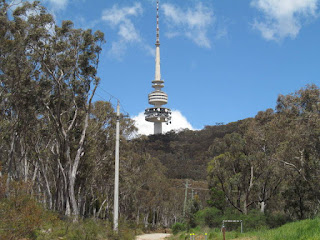Black Mountain Plants And Telstra Tower
Telstra Tower atop Black Mountain, as seen from near the Australian National Botanic Garden's nursery.
Although it was windy and cool we went for a walk on Black Mountain Nature Reserve. It is interesting how completely different its flora is compared against that of the Mount Majura - Mount Ainslie range. For example, Black Mountain has many species of orchids, the other two have only very few. Apparently the difference is to a large degree one of soil chemistry, but past land-use is also said to have differed.
Poranthera microphylla, a tiny plant that is widespread and common in south-eastern Australia, but presumably often overlooked. It was traditionally considered to be a member of the spurge family but apparently now belongs to the Phyllanthaceae.
And here is a representative of the type genus of the Phyllanthaceae, Phyllanthus hirtellus. In this case the plant is larger, a dwarf shrub, but the flowers are still minuscule.
Finally, beautiful Grevillea alpina (Proteaceae), or at least so I hope. There is another rather similar species of the same genus in the area, but it is supposed to have glabrous tepals.
Telstra Tower atop Black Mountain, as seen from near the Australian National Botanic Garden's nursery.
Although it was windy and cool we went for a walk on Black Mountain Nature Reserve. It is interesting how completely different its flora is compared against that of the Mount Majura - Mount Ainslie range. For example, Black Mountain has many species of orchids, the other two have only very few. Apparently the difference is to a large degree one of soil chemistry, but past land-use is also said to have differed.
Poranthera microphylla, a tiny plant that is widespread and common in south-eastern Australia, but presumably often overlooked. It was traditionally considered to be a member of the spurge family but apparently now belongs to the Phyllanthaceae.
And here is a representative of the type genus of the Phyllanthaceae, Phyllanthus hirtellus. In this case the plant is larger, a dwarf shrub, but the flowers are still minuscule.
Finally, beautiful Grevillea alpina (Proteaceae), or at least so I hope. There is another rather similar species of the same genus in the area, but it is supposed to have glabrous tepals.




No comments:
Post a Comment